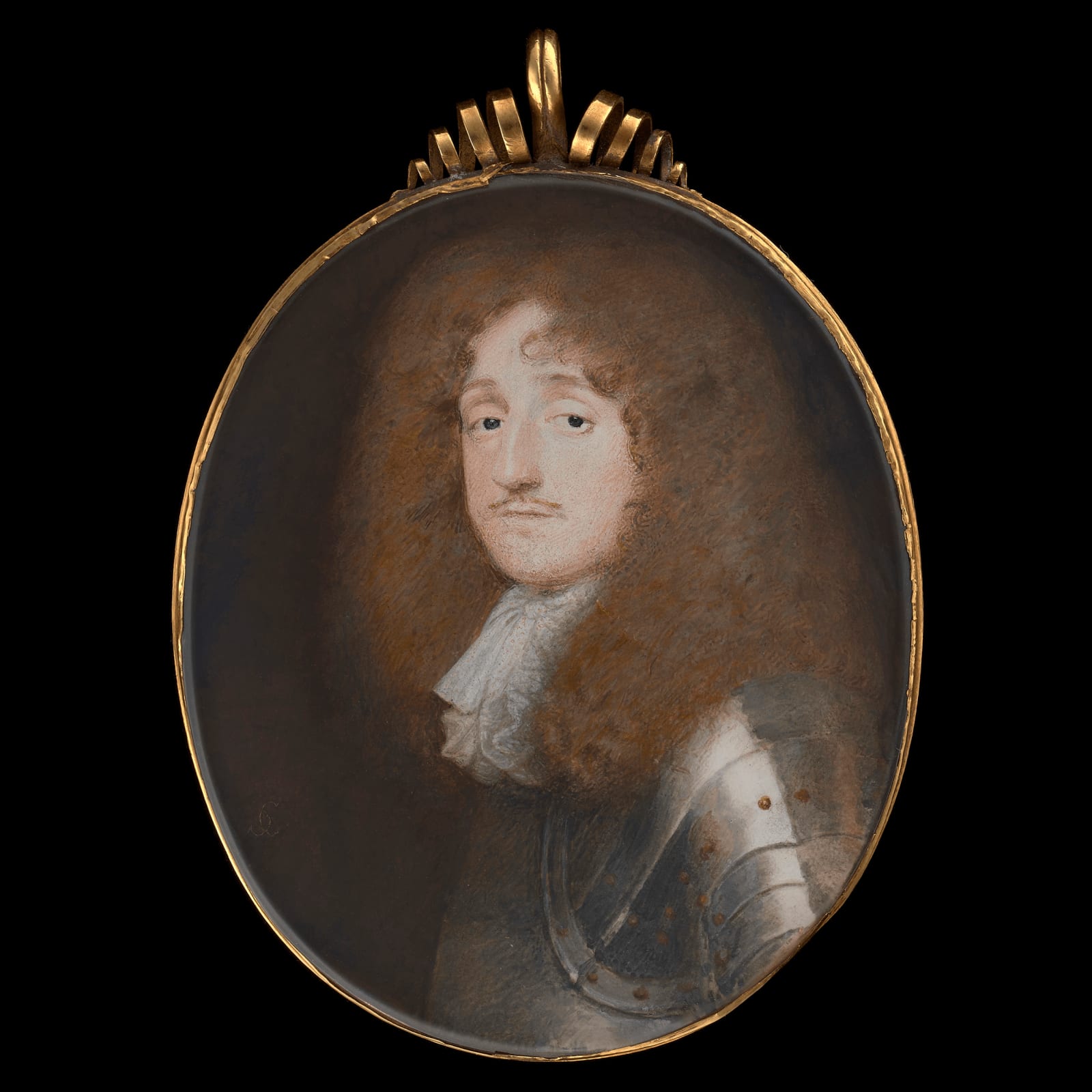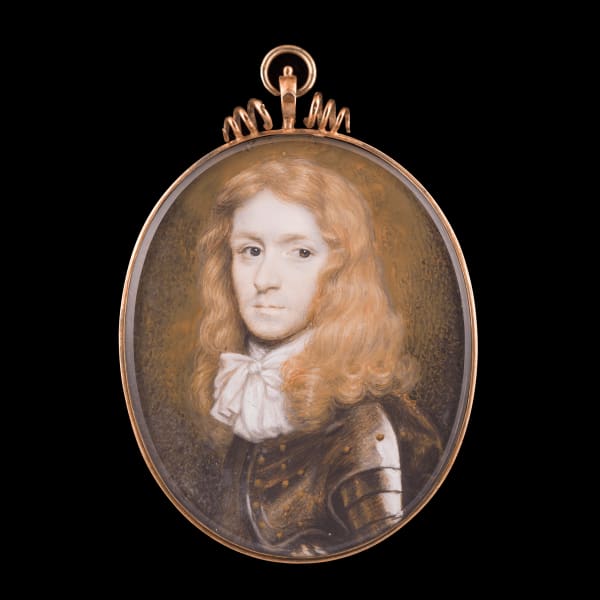
Samuel Cooper
"
To view all current artworks for sale visit philipmould.com
It is likely, however, that his general aversion to politics was for the best as May was desperately lacking in the tact that was needed by a smooth political operator. In response to news of the Great Fire of London, May callously observed that the conflagration would at least make the City easier to control, a remark that shocked even the King. Undeterred, May embarked on a number of political manoeuvres that came dangerously close to losing him his position. As MP for Midhurst in 1670, for instance, May pushed for a bill to secure a royal divorce; when the King got wind of this, he made it clear to his servant that, for all his dalliances, he was quite happily married. May stayed, but others who pursued the same course of action were not so lucky and were in 1681 suspended from court. However, May’s 1685 attempt, in consort with the Duchess of Portsmouth and others, to send the Catholic Duke of York back to Scotland proved to be one political blunder too far. Later that year, Charles – May’s protector – had died and the Duke of York had become King James II, from which point May’s services were no longer needed. This news would not have been to the consternation of all at court. Samuel Pepys ruefully remarks in his diary that May’s 1666 attempt to be nominated for the seat of Winchelsea failed due to the protestations of its electors that they ‘would have no Court pimp to be their burgesse’.[2]
May’s achievements were not, however, limited to court. An aesthete and lover of the arts, he had a valuable collection of paintings and horses, and was a friend of the architect of the new St. Paul’s Cathedral, Sir Christopher Wren, with whom he made a failed attempt to become the Member of Parliament for New Windsor. He also helped to promote the career of virtuoso woodcarver Grinling Gibbons, joining diarist John Evelyn in recommending his services to the king. He was also an investor in the late seventeenth-century building boom, having become a partner in his kinsman, Henry Jermyn, future Earl of St. Albans’s scheme to develop St. James’s Square, Piccadilly. Here his legacy endures in Babmaes Street (formerly Mews), a street that, as part of some unknown private joke, teasingly refers to May’s nickname of ‘Bab’.
It was probably a combination of May’s interest in art and the enthusiasm of the newly restored King for his own portrait miniature that led him to sit for Cooper circa 1660. Within two weeks of his return, Charles sat to the miniaturist having seen Cooper’s work while in exile and where he was ‘diverted by Mr Hobbes’s [the philosopher] pleasant discourse’.[3] The resultant portrait of May is as honest and direct as many of Cooper’s later works; here he has captured the rather irreverent and arrogant glance of the man who had the King’s ear and led his quest for entertainment at his famously debauched court.
[1] May’s mistress Dorothy Broke certainly owned the portrait but the circumstances of the original commission are unknown.
[2] The Diary of Samuel Pepys, Sunday 21 October 1666.
[3] D. Foskett, Samuel Cooper (1609-1672), London, 1974, p.45.
This portrait of the close advisor to Charles II was probably painted for his mistress circa 1660, when May was Keeper of the Privy Purse and registrar in chancery court.[1] May likely obtained this position through the machinations of Barbara Villiers, one of the king’s mistresses. The canny Villiers realised that there was great advantage to be had in having an ally in this position as the office controlled the king’s personal expenditure and, thus, could be used to encourage the cash flow in her favour. Villiers’s choice was a deft one as May was already one of the king’s closest confidantes. Having, as he would later recount, been bred about the King, May was privy to the most private of the King’s thoughts and, most enviably to his fellow courtiers, knew of the king’s latest paramour before any of his rivals. May’s continued political success came from his shrewd understanding of the fact that there were few topics that bored the King more than politics. As a result, he was one of the leading figures in Charles’s circle that awarded the “Court of the Merry Monarch” its name.
[1] May’s mistress Dorothy Broke certainly owned the portrait but the circumstances of the original commission are unknown
Provenance
Dorothy Broke, the sitter's mistress; thence by descent to Eric Saumarez, 7th Baron de Saumarez, by whom sold; Sotheby's, London, 19-21 September 2006, lot 932.Literature
D. Foskett, Samuel Cooper and his contemporaries (London, 1974) pg. 46.- X
- Tumblr
-
 Isaac OliverPortrait of Thomas Fones (d. 1638), wearing black embroidered doublet and wide lace-edged standing collar, c. 1605
Isaac OliverPortrait of Thomas Fones (d. 1638), wearing black embroidered doublet and wide lace-edged standing collar, c. 1605 -
![Peter Cross, James Scott [Crofts], Duke of Monmouth and first duke of Buccleuch (1649-85), 1681](data:image/gif;base64,R0lGODlhAQABAIAAAAAAAP///yH5BAEAAAAALAAAAAABAAEAAAIBRAA7) Peter CrossJames Scott [Crofts], Duke of Monmouth and first duke of Buccleuch (1649-85), 1681
Peter CrossJames Scott [Crofts], Duke of Monmouth and first duke of Buccleuch (1649-85), 1681 -
 Samuel CooperPortrait of Henry Alexander, 4th Earl of Stirling (d.1691), c. 1666
Samuel CooperPortrait of Henry Alexander, 4th Earl of Stirling (d.1691), c. 1666 -
 Richard GibsonPortrait miniature of a Young Gentleman wearing plate armour comprised of cuirass and spaulders secured with gilt rivets, elaborately tied with linen cravat, c. 1650-90
Richard GibsonPortrait miniature of a Young Gentleman wearing plate armour comprised of cuirass and spaulders secured with gilt rivets, elaborately tied with linen cravat, c. 1650-90 -
 Richard GibsonA Gentleman, wearing gold edged ochre doublet slashed at the sleeve to reveal white chemise, white stock and lace jabot, natural wig, c. 1650-60
Richard GibsonA Gentleman, wearing gold edged ochre doublet slashed at the sleeve to reveal white chemise, white stock and lace jabot, natural wig, c. 1650-60 -
 Richard GibsonA Lady, wearing brown dress over white chemise and blue cloak held with jewels, her light brown hair curled, c. 1675
Richard GibsonA Lady, wearing brown dress over white chemise and blue cloak held with jewels, her light brown hair curled, c. 1675 -
 Richard GibsonSir Patience Ward(e) (1629-1696), wearing black cloak and white lawn collar, his hair worn long, c. 1653
Richard GibsonSir Patience Ward(e) (1629-1696), wearing black cloak and white lawn collar, his hair worn long, c. 1653

![Peter Cross, James Scott [Crofts], Duke of Monmouth and first duke of Buccleuch (1649-85), 1681](https://artlogic-res.cloudinary.com/w_600,c_limit,f_auto,fl_lossy,q_auto/artlogicstorage/philipmouldgallery/images/view/c9eb879a0271ac4654f9fd9586a96e68p/picturearchive-historicalportraits-peter-cross-james-scott-crofts-duke-of-monmouth-and-first-duke-of-buccleuch-1649-85-1681.png)




